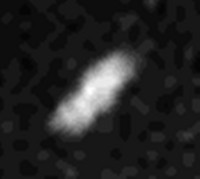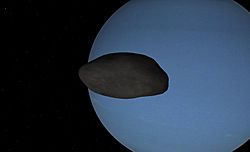Thalassa (moon) facts for kids
 Naiad or Thalassa as seen by Voyager 2 (smearing has caused excessive elongation) |
|
| Discovery | |
|---|---|
| Discovered by | Richard J. Terrile and Voyager Imaging Team |
| Discovered in | September 1989 |
| Orbital characteristics | |
|
|
|
| Semi-major axis | 50 075 ± 1 km |
| Eccentricity | 0.0002 ± 0.0002 |
| Orbital period | 0.31148444 ± 0.00000006 d |
| Inclination | 0.21 ± 0.02° (to Neptune equator) 0.21° (to local Laplace plane) |
| Is a moon of | Neptune |
| Physical characteristics | |
| Dimensions | 108×100×52 km |
| Mass | ~3.5×1017 kg (based on assumed density) |
| Mean density | ~1.2 g/cm3 (estimate) |
| Rotation period | assumed synchronous |
| Axial tilt | ~zero presumably |
| Albedo (geometric) | 0.09 |
| Surface temp. | ~51 K mean (estimate) |
| Atmosphere | none |
Thalassa or Neptune IV, is the second closest moon to Neptune. It was named after a daughter of Aether and Hemera from Greek mythology. "Thalassa" is also the Greek word for "sea".
Thalassa was discovered sometime before mid-September, 1989 from the images taken by the Voyager 2 probe. It was given the designation S/1989 N 5. The discovery was said (IAUC 4867) on September 29, 1989, but the text only talks of "25 frames taken over 11 days", giving a discovery date of sometime before September 18. The name was given on 16 September 1991.
Thalassa is not a sphere and shows no sign of any geological changes. Unusually for a non-spherical moon, it appears to be oddly shaped not able to be explained.
Images for kids
See also
 In Spanish: Talasa (satélite) para niños
In Spanish: Talasa (satélite) para niños



